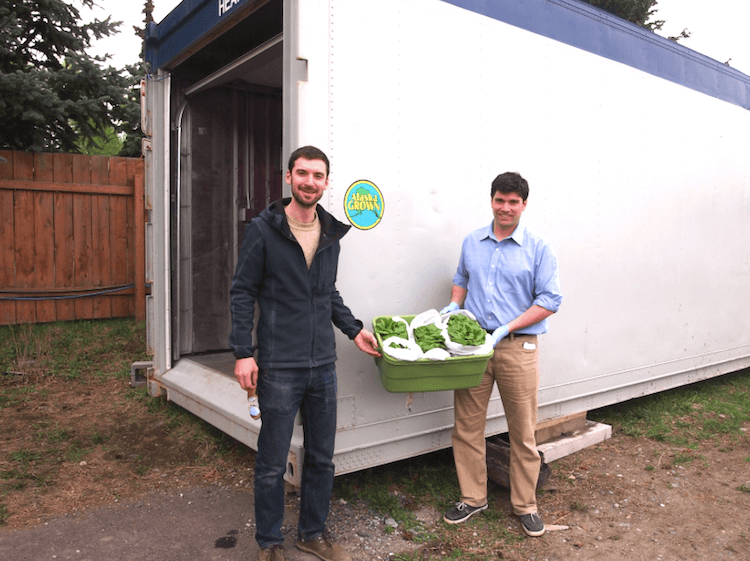

How do you turn Alaska’s icy tundras into lush, year-round farms? Two forward-thinking startups just might have found the solution: growing indoors.
Alaska Natural Organics and Vertical Harvest Hydroponics are two separate Anchorage-based indoor farm startups standing up to Alaska’s short growing seasons by using hydroponics. With this soil- and pesticide-free farming technique, plants are grown in nutrient-rich water under blue and red LED lights that mimic sunlight.

Photo credit: Vertical Harvest Hydroponics
Alaska Natural Organics—the state’s first commercial vertical farm—is growing fresh greens in tall stacks inside an old dairy warehouse in Anchorage. Meanwhile, Vertical Harvest Hydroponics designs and builds customizable “Containerized Growing Systems,” which are self-contained hydroponic farms inside a transportable, 40-foot shipping container.
While their farming approaches are very different, the two companies have similar ambitions. Each fills Alaska’s fresh food gap by cutting the distance that food has to travel to Anchorage’s plates, all while providing healthy, nutritious food options to residents.
Due to weather constraints on the growing season, Alaska imports approximately 95 percent of its food. Its produce comes from farms in California or Mexico—fruits and vegetables are picked before ripening so it doesn’t spoil during its many weeks of transport, The New York Times reported.
Consequently, fresh produce is usually much pricier for Alaskans. “I’ve seen $10 heads of lettuce in stores, so I think the economics of this project will work,” Danny Consenstein, head of the U.S. Department of Agriculture’s farm service agency in Alaska, told Alaska Dispatch News.
The Vertical Harvest units, which cost around $100,000 each, come with heating systems, shelves and electricity to support LED growing lights, co-founder Linda Janes told Alaska Dispatch News.
In all, the units are capable of producing 1,800 plants at a time in mineral-rich water without soil, Janes said. So far, the company has sold two units in Anchorage.
Alaska Natural Organics has also marked its first deliveries, with roughly 100 basil plants delivered to a handful of Alaskan grocery stores in the first week of December 2015, the Associated Press reported.
According to KTVA Alaska, when operations at Alaska Natural Organics are finally running at full capacity, the 5,000-square-foot organic farm will be able to house 20,000 plants.
https://twitter.com/AnchorageRR/status/674037914989232128
only complaint we had from a client was that it was too pretty to eat,” Winford said.
YOU MIGHT ALSO LIKE
Greenhouses: The Solution for Year-Round Local Food?
Meet This Third-Generation Farmer Who Converted His 1,400 Acres to Growing Organic Food
World’s First Off-Grid EcoCapsule Runs Entirely on Renewable Energy
Solar-Powered Water Wheel Removes 350 Tons of Trash From Baltimore Harbor

 233k
233k  41k
41k  Subscribe
Subscribe 